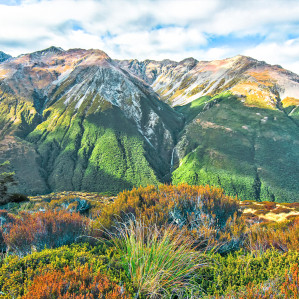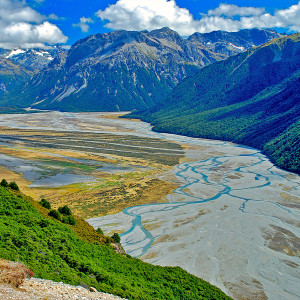What are landscapes, natural character and outstanding natural features?
The term ‘natural character’ refers to the natural attributes of areas where water bodies meet with the land around them – particularly in coastal environments, wetlands, lakes, and rivers.
Landscapes
 Landscapes, natural character and outstanding natural features add to the uniqueness of Canterbury/Waitaha.
Landscapes, natural character and outstanding natural features add to the uniqueness of Canterbury/Waitaha.
Landscapes encompass more than the area of land that we can see. We interpret a landscape, in part, depending on what it looks like, including physical components such as whether it has clear skies, mountains, lakes, pastures, forests, coastlines or urban areas.
But each landscape also reflects the history of that area, how the land has been used, who lived there or visited there and the marks they left on the land.
The landscape is influenced by the plants and animals that inhabit the area and changes to these elements over time.
Landscapes can be highly natural and unmodified or they can be highly modified and reflective of human use.
How we interpret and value the landscape depends on individual perceptions that are associated with what we see. In turn, those perceptions are influenced by our social, economic, aesthetic and cultural ideologies.
There are three broad categories of landscape attributes that contribute to our perception and understanding of the landscapes we see. These are:
- Biophysical elements, patterns and processes
- Associative meanings and values including spiritual, cultural or social associations
- Sensory or perceptual qualities
Natural character

While natural character is not the same as natural features and landscapes or amenity values, it is an integral part of any landscape that contains water.
Natural character is a statutory term that has no specific meaning outside of the Resource Management Act (RMA). Under the RMA it concerns part of the landscapes associated with the coastal environment, wetlands and lakes and rivers and their margins.
Natural character is essentially the measure of naturalness of an area that is assessed on a continuum. Greater emphasis is placed on ‘perceptions’ of naturalness in regard to landscape (i.e., a more visual basis) than on natural character (which retains a more biophysical/ indigenous emphasis).
Natural character has three main components:
- Natural processes
- Natural elements
- Natural patterns
As with landscape, natural character is influenced by how people experience the three components. This includes things like smells, sounds, the natural darkness of the sky, the context and setting of the environment. Also, in common with landscapes, natural character exists to some degree in all coastal, wetland, lake, riverine environments, even in highly modified environments because of the continued influence of natural processes.
Outstanding natural features
An outstanding natural feature is usually a landform that is smaller than an entire landscape but is distinct and easily identifiable. It is something that rates as outstanding in at least one of the following values:
- Geoscience significance – the landform, feature or geological site contributes to the understanding of the geology or evolution of the biota in the district, region, New Zealand/Aotearoa or the earth
- Rarity – the physical process or geological exposure of the feature is rare or unique within the district or region, and few comparable examples exist
- Scenic/aesthetic values – the natural feature is visually striking, has scenic beauty, or is iconic and publicly appreciated
- Tourism and/or recreational values – the feature is used or has potential for tourism or recreation because of its natural attributes
- Community values – the natural feature is widely known and highly valued for its contribution to local identity within its community
- Educational values – the feature has existing or potential value for public education.

